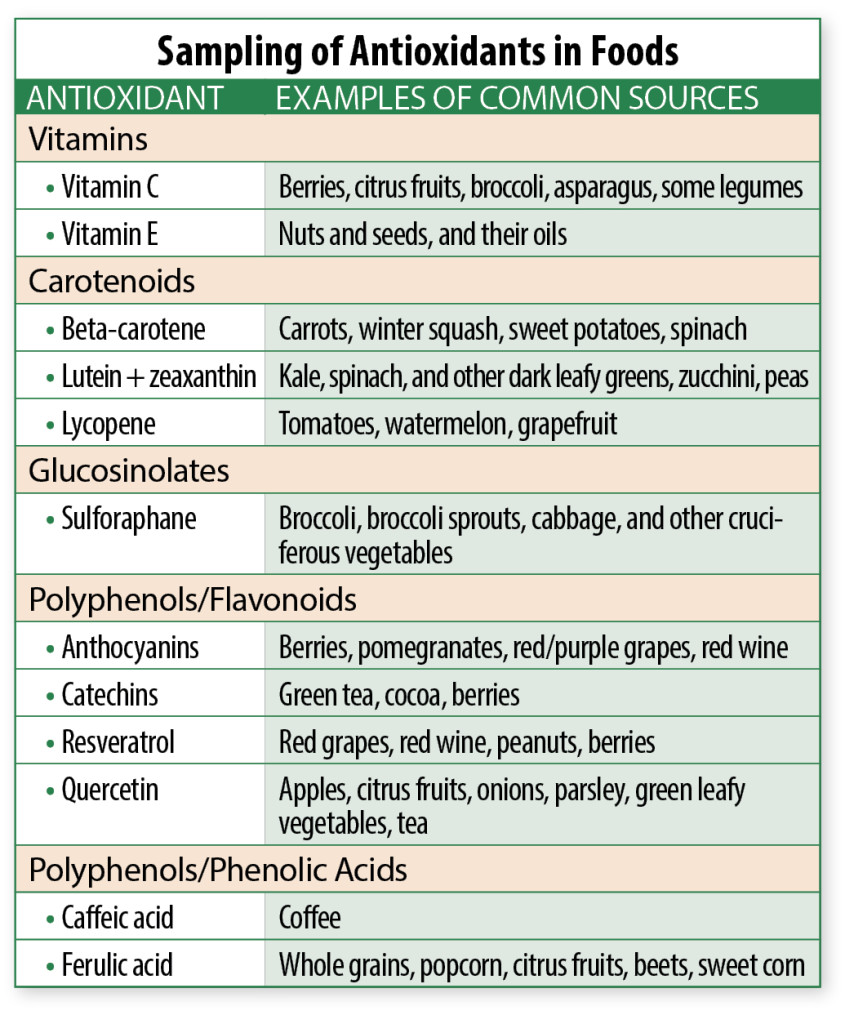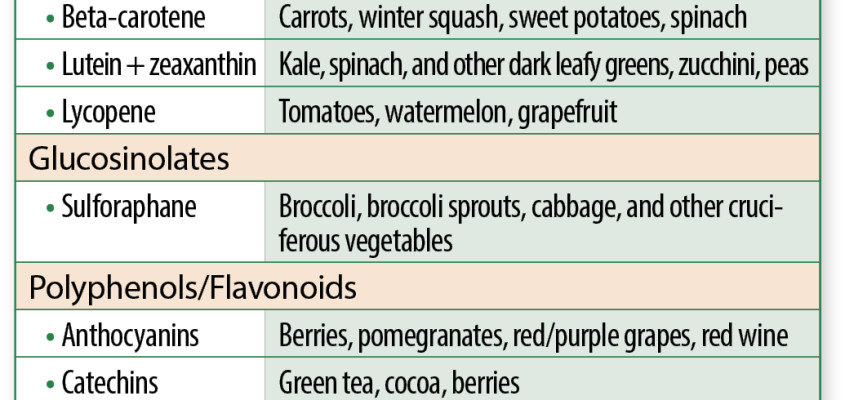An Antioxidant Boom
 You’ve likely heard of antioxidants, even if you’re not sure what they do. They’re frequently touted on food packages, such as nutrition bars and breakfast cereals, not to mention in promotions of the latest “superfoods” and a host of dietary supplements. The marketing of such products, however, is a bit ahead of the science. It’s important to understand a little about antioxidants to make better choices at the store and when planning meals.
You’ve likely heard of antioxidants, even if you’re not sure what they do. They’re frequently touted on food packages, such as nutrition bars and breakfast cereals, not to mention in promotions of the latest “superfoods” and a host of dietary supplements. The marketing of such products, however, is a bit ahead of the science. It’s important to understand a little about antioxidants to make better choices at the store and when planning meals.
Antioxidants in Action. Antioxidants defend against free radicals—molecules that can damage our bodies’ cells and cause them to work poorly or die. The goal isn’t to squelch all free radical generation in our bodies, though. For example, without the processes that produce them we wouldn’t be able to get energy from the foods we eat or fend off infectious agents. Rather, the goal is to keep free radicals in check with the help of antioxidants so there isn’t an imbalance. It’s believed that cellular damage from increased free radical formation is a contributor to diseases such as cancer, diabetes, cardiovascular disease, and certain eye diseases.
Finding Antioxidants. Our body makes some antioxidants, and there are many compounds in foods with antioxidant roles, such as certain vitamins (like vitamins C and E) and natural plant substances called phytochemicals. Seemingly countless different phytochemicals are in foods. Scientists have put them into groups, such as polyphenols and carotenoids, based on their chemical structure.
Fruits and vegetables are often viewed as the go-to sources for phytochemical antioxidants. However, you’ll also find antioxidants in whole grains, nuts (especially in their papery skins) and seeds (and their oils, especially if unrefined), legumes, herbs and spices, dark chocolate, and drinks such as tea and red wine. When planning what to eat, try to get a variety of different plant food groups in a meal and over the course of a day. That way you’ll get a greater array of phytochemicals, often signaled by plant foods’ vibrant colors.
Hummus and Veggie Wrap
This recipe provides antioxidants from a
variety of food groups.
1 (8-inch) whole-grain tortilla
¼ c hummus
¼ c baby spinach leaves
2 Tbsp chopped, toasted walnuts
2 Tbsp chopped red bell peppers, roasted or raw
2 Tbsp coarsely shredded carrot
8 slices peeled cucumber
Makes 1 serving
Nutrition Information Per Serving: 349 calories, 18 grams (g) fat,
2 g saturated fat, 36 g carbohy-drate, 12 g protein, 8 g dietary fiber,
396 milligrams sodium.
Recipe courtesy of the California Walnut Board
Assessing Antioxidant Supplements. Several decades of observational research suggest consuming antioxidant-rich foods may help protect against disease. However, such research can’t show cause and effect; for that, clinical trials are needed and typically focus on supplements. Although some trials of high-dose anti-oxidant supplements have been done in large groups of people, they have failed to show a benefit in preventing chronic disease. In fact, limited evidence suggests this approach might even be harmful. For example, such tri-als have found supplementing with high doses of vitamin E may increase risk of prostate cancer and hemorrhagic (bleeding) stroke.
Why clinical trials of antioxidant supplements haven’t panned out is uncertain. As expressed in a July 2016 review in the British Journal of Pharmacology, the relationship between antioxidants and free radicals in our health is likely more complex than once thought. Furthermore, it could be that some of plant foods’ benefits are coming from substances other than antioxidants or from a synergy of multiple nutri-ents. Or, differences in the chemical composition of antioxidants in foods versus supplements could impact ef-fectiveness. For example, only one form of vitamin E has been used in antioxidant studies, but foods contain eight different forms of vitamin E.
Since it’s unclear whether antioxidant supplements may cause harm in certain cases, the best ap-proach, in general, is to consume a variety of whole and minimally processed plant foods daily. That ensures you’re getting everything that makes these foods so good for us, rather than just isolated antioxidants with uncertain effects.
—Marsha McCulloch, MS, RD
The post An Antioxidant Boom appeared first on University Health News.
Read Original Article: An Antioxidant Boom »
Powered by WPeMatico


